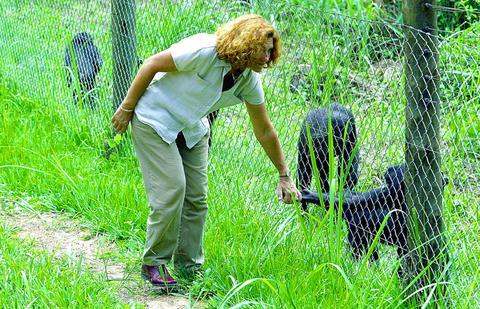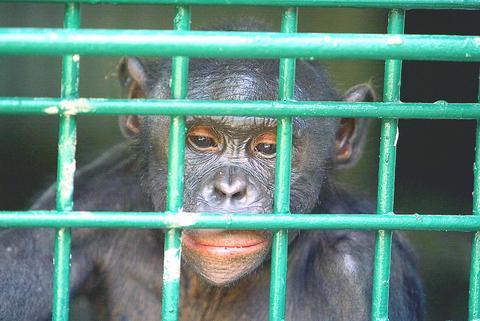Upstream from this dog-eat-dog capital, where the Congo River spills its tributaries into the belly of the equatorial rain forest, lies the jungle home of one of mankind's closest cousins and one of the most endangered primates on earth: the bonobo.
Genetically, humans and bonobos, a species of chimpanzee, are more than 98 percent similar. Socially, it is another matter. Matriarchal as a rule, bonobos eschew conflict. They do not fight over territory. They do not kill. Any small friction they resolve through sexual contact: a playful rub, oral sex, full intercourse.

PHOTO: NY TIMES
Peace-loving they may be, but during Congo's latest war, the bonobos' jungle habitat fell smack on the front line between two fighting factions.

PHOTO: NY TIMES
Fishing and farming all but ground to a halt during the war, which officially ended last year. Civilians and soldiers alike turned to the forest to fill their bellies.
More and more, the bonobos turned up as supper. Their smoked remains showed up at riverine markets. Babies were orphaned, which is to say they were more or less destined to die: The bonobo infant, accustomed to staying on its mother's back for the first few years of life, has great trouble surviving on its own.
So it was that the bonobo orphans of the central African rain forest found themselves hurtling hundreds of kilometers down the Congo River to this gritty metropolis and into the arms of a redheaded Frenchwoman called Claudine Andre.
Andre recalls it as love at first sight. More than 10 years ago, after a famous, ruinous pillage of Kinshasa, Andre, then a businesswoman, went to the ravaged city zoo and chanced upon a bereft infant bonobo. He looked as though he wanted to die, she recalled. She named him Mikano, took him home and became, in her words, his surrogate mother.
When the war came, more orphans trickled in. She kept them on the grounds of an elite American school. Then, last year, when peace came, she opened Lola Ya Bonobo, a sanctuary for orphaned bonobos on a 75-acre patch of green on the fringes of the capital.
Infants are paired with surrogate mothers. There is an endless supply of bananas and sugar cane (bonobos have an incurable sweet tooth). An electric fence encircles the park, to keep the apes from scampering out of the woods and into Kinshasa's traffic. The park is open to visitors.
On a recent Sunday afternoon, the park's 31 young charges did what young bonobos do: chewed on blades of grass, swung from palm fronds, kissed, frolicked and fondled.
"It's the hippies of the forest," Andre said, taking their wrinkled hairy hands in hers. "When they feel anxious, when they are afraid, they have sex. And they calm down."
As if on cue, a big bonobo mounted a small bonobo. They rolled around on the grass, rubbed themselves against each other and went on their merry ways.
Bonobos are not proprietary about mates and sex is not always about procreation. Homosexuality is common, and sexual play begins when they are barely a year old, though intercourse must wait until they are teenagers. Much to Andre's delight, a teenage orphan, a male, arrived recently. Hopefully, she said, mating will soon begin.
"It's really make love, not war," Andre said of the bonobo way of life. "It was so sad to see such a pacific animal so destroyed by war."
The plight of the bonobos, a species found only in Congo, is a window into the repercussions of war on the ecology of the Congo River Basin, one of the most diverse ecosystems in the world and home to more than 400 species of mammals. Mining, logging and a sustained trade in bush meat have all put the squeeze on their habitats.
War having made vast swaths of the country inaccessible to researchers, it is impossible to know precisely how these creatures have fared. Certain habitats may have been left untouched, but others have been devoured.
In the Virunga Highlands near the border of Uganda and Rwanda, the mountain gorilla population has grown, according to a census by the Wildlife Conservation Society. By contrast, in the Kahuzi-Biega National Park, the eastern lowland gorilla's population has fallen by 70 percent to fewer than 5,000, according to Conservation International. The elephants in the same park may well have vanished.
As for the bonobo population, scientists have no reliable numbers but fear the species may be nearing extinction. Late last year, the UN Environment Program reported that the bonobo, along with the gorilla, chimpanzee and orangutan, could disappear in 50 years.
Peace is likely to present a new challenge to forest dwellers: Congo's rain forests have once again opened up to logging companies and today the first batches of timber can be seen floating downriver from Equateur province to the port in Kinshasa. With blessings from the World Bank, 150 million acres of rain forest could be opened up for logging.
As the World Bank sees it, timber concessions could pour hundreds of millions of dollars into government coffers. Environmentalists fear that the logging could also endanger the habitat of the Pygmy people, who have eked out a living in the forest for centuries. The bonobos are sometimes called Pygmy chimpanzees, because Pygmies too are averse to conflict; they too prefer to hunt and forage in the forest rather than fight one another for territory. UN investigators suspect some of them had been eaten during the war too.

In the next few months tough decisions will need to be made by the Taiwan People’s Party (TPP) and their pan-blue allies in the Chinese Nationalist Party (KMT). It will reveal just how real their alliance is with actual power at stake. Party founder Ko Wen-je (柯文哲) faced these tough questions, which we explored in part one of this series, “Ko Wen-je, the KMT’s prickly ally,” (Aug. 16, page 12). Ko was open to cooperation, but on his terms. He openly fretted about being “swallowed up” by the KMT, and was keenly aware of the experience of the People’s First Party

Aug. 25 to Aug. 31 Although Mr. Lin (林) had been married to his Japanese wife for a decade, their union was never legally recognized — and even their daughter was officially deemed illegitimate. During the first half of Japanese rule in Taiwan, only marriages between Japanese men and Taiwanese women were valid, unless the Taiwanese husband formally joined a Japanese household. In 1920, Lin took his frustrations directly to the Ministry of Home Affairs: “Since Japan took possession of Taiwan, we have obeyed the government’s directives and committed ourselves to breaking old Qing-era customs. Yet ... our marriages remain unrecognized,

During the Metal Ages, prior to the arrival of the Dutch and Chinese, a great shift took place in indigenous material culture. Glass and agate beads, introduced after 400BC, completely replaced Taiwanese nephrite (jade) as the ornamental materials of choice, anthropologist Liu Jiun-Yu (劉俊昱) of the University of Washington wrote in a 2023 article. He added of the island’s modern indigenous peoples: “They are the descendants of prehistoric Formosans but have no nephrite-using cultures.” Moderns squint at that dynamic era of trade and cultural change through the mutually supporting lenses of later settler-colonialism and imperial power, which treated the indigenous as

Standing on top of a small mountain, Kim Seung-ho gazes out over an expanse of paddy fields glowing in their autumn gold, the ripening grains swaying gently in the wind. In the distance, North Korea stretches beyond the horizon. “It’s so peaceful,” says the director of the DMZ Ecology Research Institute. “Over there, it used to be an artillery range, but since they stopped firing, the nature has become so beautiful.” The land before him is the demilitarized zone, or DMZ, a strip of land that runs across the Korean peninsula, dividing North and South Korea roughly along the 38th parallel north. This